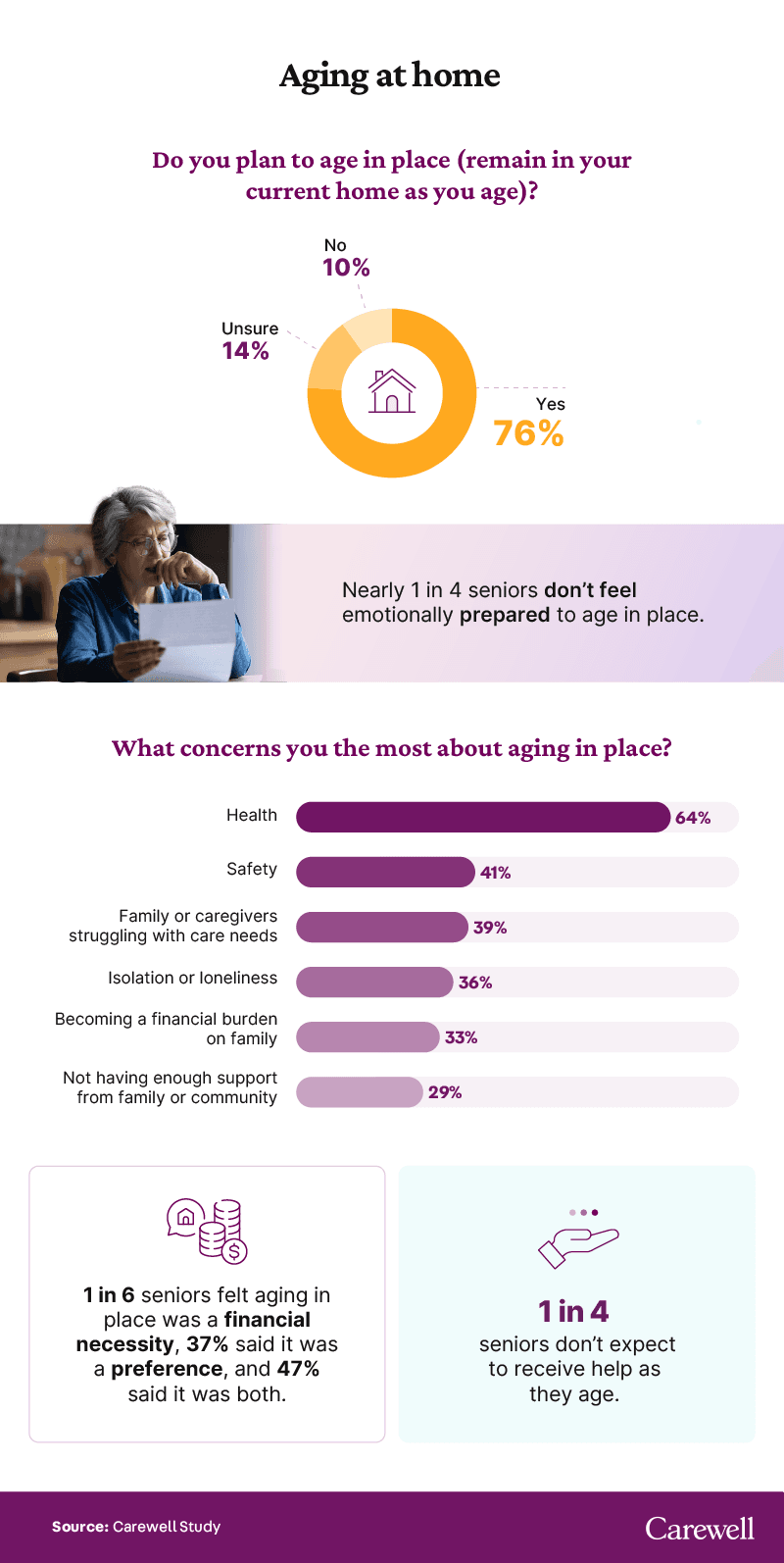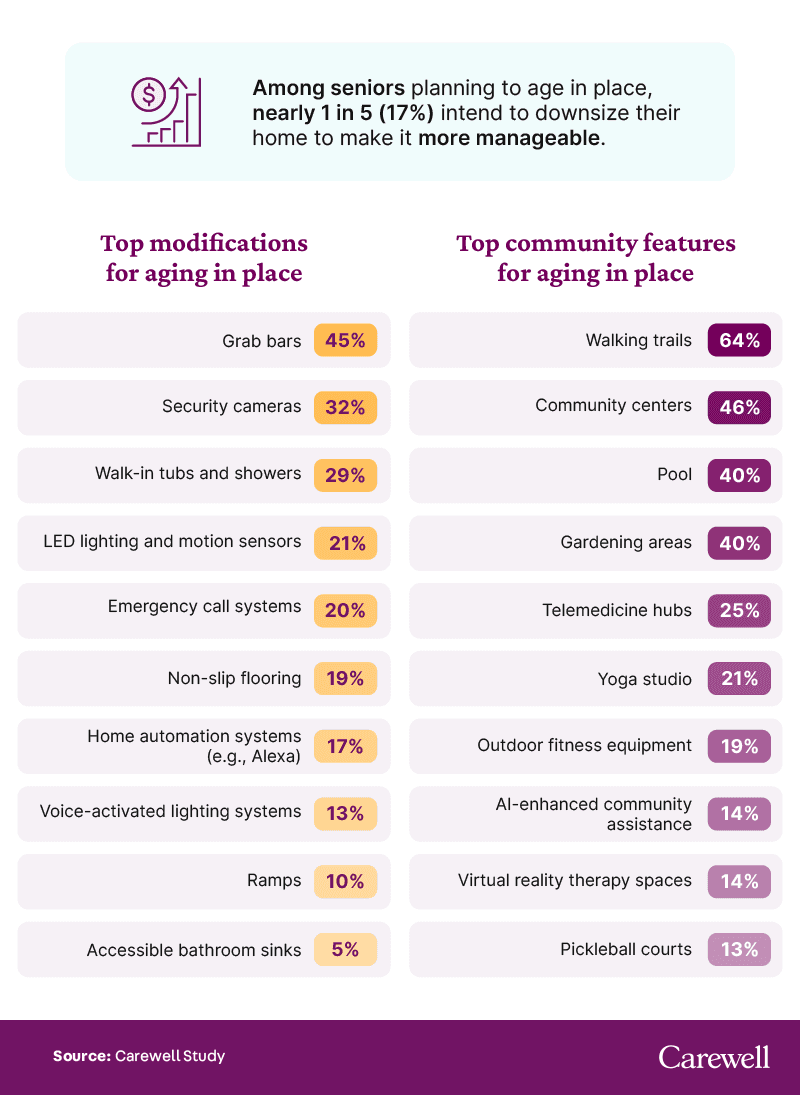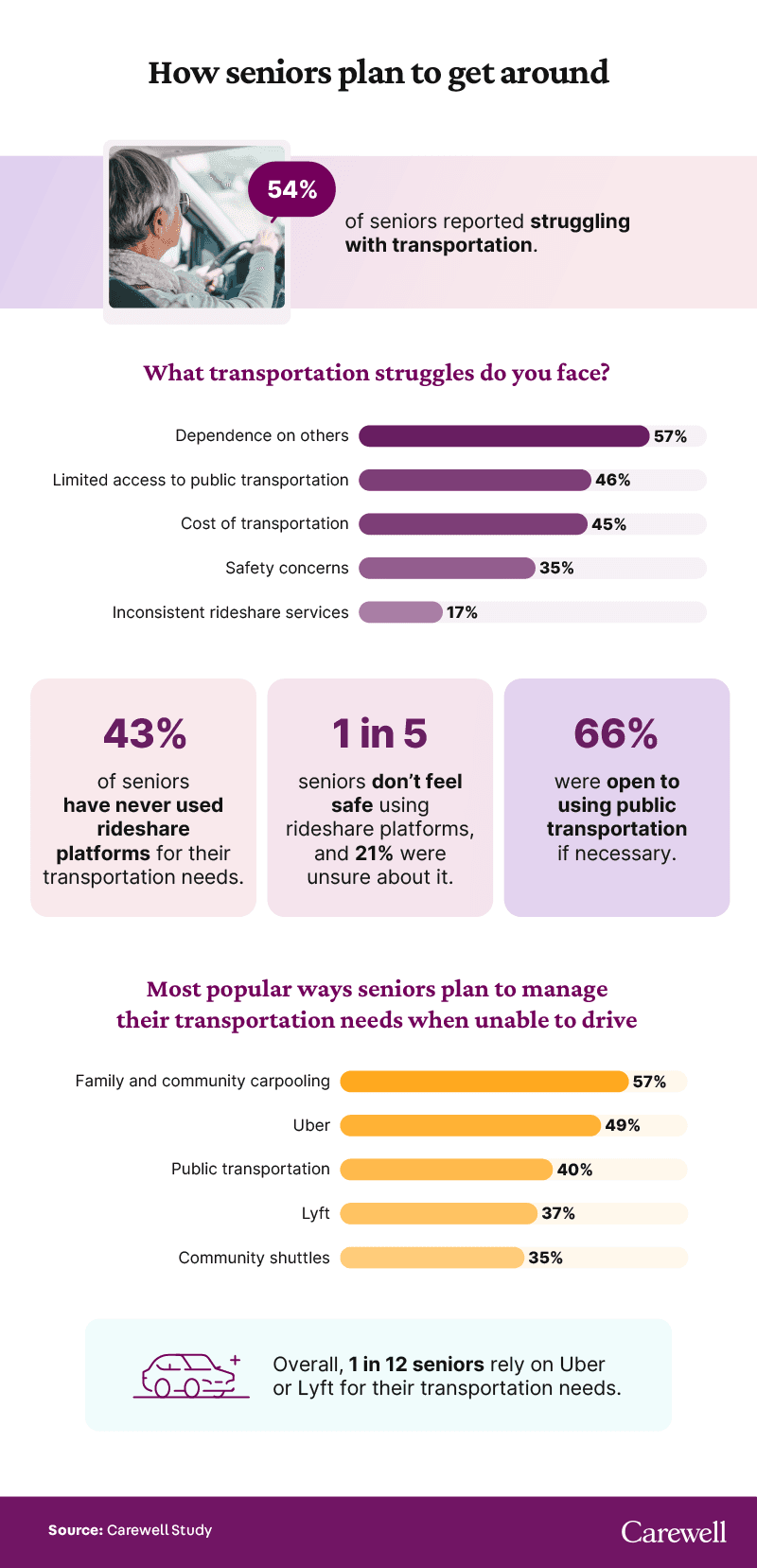Aging in place means different things to different seniors — for some, it's about staying in familiar surroundings, while for others, it's their only option. Older adults are balancing factors like safety, home modifications, transportation, and available support to maintain their independence. Exploring these preferences and challenges reveals both the appeal of aging in place and the reasons some may seek alternative living arrangements.
Key Takeaways
While 37% of seniors say aging in place is their preference, 1 in 6 view it as a financial necessity.
1 in 4 seniors don't expect to receive help as they age.
1 in 12 seniors rely on Uber or Lyft for their transportation needs, yet 43% have never used a rideshare service.
56% of seniors report struggling with transportation, with the top issue being dependence on others (57%).
Charlotte, North Carolina, tops seniors' list for retirement relocation.
Senior Preferences and Worries
Aging in place — the ability to live in one's own home and community safely, comfortably, and independently for as long as possible — is a popular goal for many older adults. However, they have some concerns.

For 37% of seniors, aging in place is a preference, but for 1 in 6, it's a financial necessity. The rest — 47% — said the choice came down to both their preferences and finances. Where seniors live also affected their outlook on aging at home, with some experiencing safety concerns or uncertainty about staying at home.
Seniors in rural areas were the most likely to say they're planning to age in place (81%). Many urban (77%) and suburban (73%) seniors also plan to stay in their current homes, but those in the suburbs were the most uncertain — 27% felt unsure or unwilling to stay. Almost a quarter of city dwellers (23%) felt the same. Safety was also a bigger challenge for urban seniors, with 48% concerned about their neighborhoods as they age.
Support systems are also key to aging at home, but not everyone expects to have help. Alarmingly, 1 in 4 seniors don't anticipate receiving any assistance as they grow older, which may shape their plans for independent living.
Downsizing is another option some are exploring, especially in cities, where 22% plan to reduce their living space for a simpler lifestyle.

As seniors plan for the future, certain community features and home modifications become more important. Some older adults are looking for unique additions, like the 1 in 8 who would like access to pickleball courts.
Another 1 in 9 were interested in drone delivery ports — designated areas designed for drones to safely land and deliver packages. Communities that focus on safety, connection, and convenience can help older adults live independently and comfortably for longer.
From Carpooling to Uber
Transportation is one of the biggest challenges for older adults, especially as they aim to stay mobile and independent. Many seniors find it difficult to get around, often depending on others for rides or navigating unfamiliar transportation services.

More than half of seniors (56%) reported struggling with transportation, with 57% saying their top challenge was relying on someone else to get where they need to go. Transportation difficulties were more common in rural areas, where 56% of seniors have experienced these issues.
While ridesharing services like Uber and Lyft offer a modern solution, many seniors have yet to embrace them. Only 1 in 12 older adults have relied on these services, and 43% said they have never tried them. These findings highlight the importance of creating accessible, reliable transportation options that meet the needs of older adults, regardless of where they live.
Why Aging in Place Isn't for Everyone
While many older adults prefer the idea of staying in their current homes, aging in place isn't the right fit for everyone. Some worry about losing independence or feel their homes aren't designed to meet their changing needs as they age.

Nearly 1 in 6 seniors (14%) were worried that aging in place could limit their independence, raising questions about whether staying home is always the best option.
Surprisingly, suburban seniors — often thought to have ideal living conditions with spacious homes and family-oriented neighborhoods — reported the greatest concern, with 60% saying their homes weren't equipped for comfortable aging. In contrast, city-dwelling seniors expressed the most confidence, with 42% believing their homes were well-suited to support them as they grow older.
Retirement relocation is gaining traction among seniors looking for communities that offer the amenities, safety, and support systems needed to meet their needs. Charlotte, North Carolina, emerged as the top destination of choice for aging in place or retiring. Sarasota, Florida, and Seattle, Washington, were also popular locales for older adults.
Why Aging in Place Matters
Aging in place offers older adults the chance to maintain independence and stay connected to the communities they know and love. However, it's not without its challenges. Ensuring that seniors have access to safe and functional homes, reliable transportation, and supportive networks is essential to helping them thrive in their golden years.
For some, adapting to their current environment makes this possible, while others may find that alternative living arrangements better suit their needs. Ultimately, aging in place is about giving seniors the choice to live on their terms, with dignity and comfort.
Methodology
We surveyed 1,053 seniors to explore their preferences, challenges, and needs regarding aging in place. For this study, we defined senior adults as individuals aged 55 and older. The data was collected in October 2024.
About Carewell
Carewell is a labor of love, founded by a family passionate about supporting caregivers and their loved ones. We know firsthand the challenges and triumphs of the caregiving journey, and we're here to make your path a little smoother. With a wide range of home healthcare products and a team that truly cares, we're committed to being your trusted partner in providing exceptional care at home.
Fair Use Statement
If you share this content, please credit Carewell and link back to this page to support our exploration of seniors' preferences for aging in place. Content may be shared for noncommercial purposes only.






